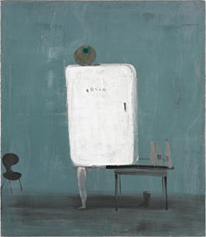1 May – 18 August 2013
Norbert Schwontkowski
The Inner Architecture of a Painting
Last year the Art Prize of the Dieter Krieg Foundation was awarded for the first time. This prize goes hand-in-hand with an exhibition at Kolumba, the prize money providing the basic sum for the purchase of a group of works for the collection. - The first award-winner is painter Norbert Schwontkowski, who was born in 1949 and lives in Bremen and Berlin. His paintings reflect great existential issues; they accomplish this without taking recourse to pathos or ponderousness, however. Rather, they display a playful lightness, a clarity and air of cheeriness, which touches us over and over again anew. Schwontkowski is interested in the human condition, the nature of man, and fathoms its light and dark sides. He roams through the world with an alert gaze, and in doing so, finds ordinary everyday scenes and events that tell of the conditions and limits of human existence. He is interested just as much in the smaller worries as he is in the great political issues. Or, as he himself describes it: "This is precisely my great theme: As an artist, I do not have a certain area on which I concentrate my work, I do not concern myself with anything concrete. I only have this one, most human of themes, life and death - but this hones in on the essential point. This is story enough for me." - Painting is memory - in Schwontkowski's paintings, this claim associated with the medium may be experienced very concretely: His work is geared to working the ground of the painting; layer for layer, the material is applied and removed again, and with swift gestures, deeper-lying layers are brought to light again. This method of working - so-to-speak, archaeological in nature - is visible not only on the differentiated surfaces, which also change over the course of time, but also at the edges of the painting, where the color mass gathers to become a plastically formed edge. Some paintings unfold their effect slowly, evoke concrete memories, open up when we look at them more closely, allegorical spaces, and actually become paintings fraught with meaning. Others, by contrast, are of greatest immediacy; they seem as if the painter had thrown them on the canvas spontaneously. These are not meticulous compositions, no sophisticated painting constructions - but quick brushstrokes flicked from the wrist. - An important component of Schwontkowski's painting language is the picture titles, which strip the motifs of their everyday quality, transposing them into a strange state of suspension. What takes place here in the interim space between image and language, seems spontaneous on the one hand - like an idea hit upon by a stroke of luck - but on the other hand, it is of a precision that makes us doubt the immediacy of the picture's invention. In the back and forth between image and language, the painting's idea is heightened in a way "that in the best case scenario, exudes something like a permanent suddenness" (NS) Thus, Schwontkowski's painting does not simply arise from intuition, and it is anything but nonreflective. Suggestively, it plays upon various painting traditions - feeding upon Romanticism, Eastern Asian Art, and last but not least, poetry and the wit of Surrealism.



